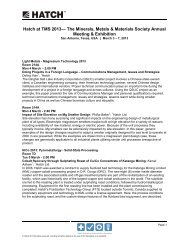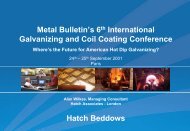Download PDF - Hatch
Download PDF - Hatch
Download PDF - Hatch
Create successful ePaper yourself
Turn your PDF publications into a flip-book with our unique Google optimized e-Paper software.
An incredible journey<br />
The design, manufacture<br />
and global transportation<br />
of the world’s largest autoclaves<br />
Each 780-tonne autoclave<br />
took 18 days to be<br />
transported just over<br />
120 kilometres from<br />
the port at Samana,<br />
Dominican Republic,<br />
to the Pueblo Viejo<br />
operation.<br />
The Pueblo Viejo gold operation<br />
in the Dominican Republic is on<br />
track for its first gold pour in the<br />
first quarter of 2012. But getting<br />
to this point has not exactly<br />
been easy sailing. Because<br />
the ore is double refractory, in<br />
order to access it, the project<br />
had to commission the largest<br />
autoclaves ever built and<br />
transport them halfway across<br />
the world from Malaysia to the<br />
Caribbean.<br />
Accessing gold<br />
Pueblo Viejo, a joint venture<br />
between Barrick Gold<br />
Corporation and Goldcorp Inc.,<br />
boasts gold reserves of<br />
approximately 23.7 million<br />
ounces. Barrick owns 60 per<br />
cent and is the managing<br />
partner. The sulphidic refractory<br />
gold deposit is being constructed<br />
to a 24,000 tonne-per-day design<br />
capacity. In the first five years, it<br />
will produce an average of 1.042<br />
to 1.125 million ounces annually<br />
(100 per cent basis).<br />
<strong>Hatch</strong> Autoclave Technology<br />
Group has been on the project<br />
since 2006 with the engineering,<br />
procurement, construction<br />
management (EPCM) contract<br />
for the core part of the refractory<br />
process, namely, the autoclaving<br />
facility and supporting oxygen<br />
plant. “It’s a double refractory<br />
gold ore, associated with two<br />
mineralogical issues: sulphides,<br />
in the form of pyrite and minor<br />
base metals such as silver,<br />
copper and zinc, which prevent<br />
cyanidation from directly<br />
recovering the gold; and a<br />
natural carbon component to the<br />
ore, which causes issues with the<br />
recovery under a conventional<br />
system,” explains <strong>Hatch</strong> project<br />
manager Kevin S. Fraser. The<br />
incorporation of autoclaving<br />
in the processing of the ore<br />
addresses these challenges.<br />
In the autoclaves, all sulphides<br />
are oxidized, producing<br />
sulphuric acid as a by-product.<br />
The iron, copper and zinc<br />
dissolve into the solution; then<br />
the acid is washed out in a<br />
counter-current decantation<br />
(CCD) circuit leaving free<br />
microscopic gold to allow<br />
for leaching in cyanide. The<br />
<strong>Hatch</strong> Advantage July 2011 | 11



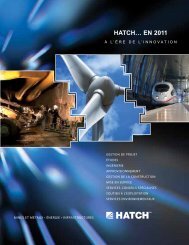
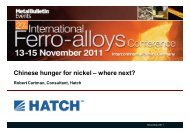
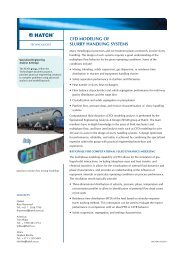




![Presentation: Global Overview of Line Pipe [pdf, 618 KB] - Hatch](https://img.yumpu.com/22183381/1/190x132/presentation-global-overview-of-line-pipe-pdf-618-kb-hatch.jpg?quality=85)
![Sustainable Development Report 2010 [pdf, 2.13 MB] - Hatch](https://img.yumpu.com/22183361/1/190x245/sustainable-development-report-2010-pdf-213-mb-hatch.jpg?quality=85)
![This is Hatch 2011 - Our Organization [pdf, 636 KB]](https://img.yumpu.com/22183357/1/190x245/this-is-hatch-2011-our-organization-pdf-636-kb.jpg?quality=85)
![Annual Review - This is Hatch 2006 [pdf, 1.88 MB]](https://img.yumpu.com/22183355/1/190x245/annual-review-this-is-hatch-2006-pdf-188-mb.jpg?quality=85)
![Hatch Safety Report 2007 [pdf, 2.89 MB]](https://img.yumpu.com/22183353/1/190x245/hatch-safety-report-2007-pdf-289-mb.jpg?quality=85)
![Structural Assets Newsletter #16, October 2002 [pdf, 322 KB] - Hatch](https://img.yumpu.com/22183350/1/184x260/structural-assets-newsletter-16-october-2002-pdf-322-kb-hatch.jpg?quality=85)
